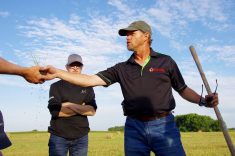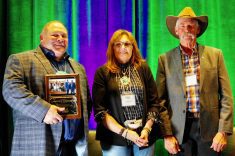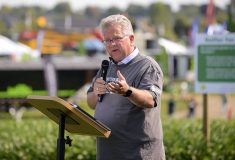In late January, U.S. conservation ag guru Ray Archuleta asked for four volunteers to come to the front of the room and help him with an experiment.
Called the ‘slake test’ it was designed to demonstrate soil stability to the 100 attendees at a soil health workshop at the Shevchenko Ukrainian Centre in Rosa.
Archuleta, a longtime employee of the United States Department of Agriculture’s Natural Resource Conservation Service turned consultant, had lined up four large graduated cylinders filled with water.
Read Also

Mazergroup’s Bob Mazer dies
Mazergroup’s Bob Mazer, who helped grow his family’s company into a string of farm equipment dealerships and the main dealer for New Holland machinery in Saskatchewan and Manitoba, died July 6 from cancer.
He gave each volunteer a chunk of air-dried soil. One sample was from a regularly tilled field in Missouri, another from a cover crop, no-till field from his own farm in Missouri.
The other two were from Manitoba with a tilled sample and another from a no-till pasture field. Archuleta explained that if the soil falls apart, it is missing the organic compounds that act as “superglues” to bind the silts, sands and clays together.
The volunteers placed the samples into the cylinders where they were suspended on a screen. Within seconds the two tilled samples began breaking down. The pasture field sample broke down much more slowly, while the cover crop, no-till sample from Missouri, barely broke down at all.
“What started the movement in the United States were demonstrations like these,” said Archuleta. “It’s a demonstration that has connected people back to the soil. I love these demonstrations because the soil is speaking to us. I’m just interpreting what the soil is telling us.”
The other big draw at the meeting was Gabe Brown, a North Dakota rancher from the Bismarck area who’s become a rock star of the regenerative movement.
Where Archuleta’s presentation was more visual, Brown got down to the nitty-gritty with detailed analysis and comparisons of the various methods of regenerative agriculture versus traditional methods.
Brown is considered a pioneer of the movement. With his wife Shelly and his son Paul, Brown operates a diversified 5,000-acre farm and ranch near Bismarck, North Dakota. He bought the ranch from his father-in-law in 1991 and has integrated principles of regenerative agriculture to improve the health of the soil.
The Brown Ranch hosts over 2,000 visitors a year from people interested in his methods of agriculture. In 2018, Brown authored the book, Dirt to Soil, One Family’s Journey Into Regenerative Agriculture. Along with Archuleta, he is a partner in Understanding Ag LLC, and he is an instructor for the Soil Health Academy.
The crux of Brown’s message to the Rosa audience was that the soil is a direct reflection of the farmer. He showed slides comparing soil samples from his own farm with those of neighbours to illustrate that point.

“Every decision you make on your farm has compounding, cascading effects,” said Brown. “They’re either positive or negative – never neutral.”
The comparisons of Brown’s soil with his neighbours’ were vastly different. And he says it all comes down to stewardship – the choices the farmer makes.
“If all you want to do is grow corn and beans, so be it. But don’t come to me and say my soils are poor. I’m not going to feel sorry for you. You can only change that if you change the compaction between your ears,” he joked.
The Brown Ranch follows some simple guidelines that Brown says lead to a healthy soil ecosystem. These six guidelines are essentially the guiding principles of the regenerative agriculture movement.
The first is context.
“We all have an ecological context, you’re not going to grow the same things here as a farmer in Florida,” said Brown.
But it goes beyond environmental context; it also extends to financial context, the size of the farm, and resources available.
The second principle is employing the least amount of chemical and mechanical disturbance possible.
The third principle is creating a “soil armour” with cover crops.
The fourth is to diversify cash crops grown.
The fifth is to leave the living root in the soil for as long as possible.
The sixth and final principle was the integration of livestock into the cycle.
The idea with these principles is to mimic as closely as possible, the way nature works.
While soil health and environmental stewardship are important aspects of the movement, one of the key messages that both Brown and Archuleta emphasized was that following these principles is also a path to a better bottom line for farmers. That is the message that seems to resonate most with the audience in Rosa, as well as audiences around the globe. A quick Google search shows that their YouTube videos have hundreds of thousands of views.
Some of the growers in attendance were quite familiar with these principles and have been dabbling in them with some success.
“I’ve been watching his videos for years and we’ve been trying it out on our farm,” said Markus Dueck, who runs a farm near Beausejour.
Dueck, who was also one of the volunteers called up by Archuleta during his presentation, says he’s been happy with the results.




















